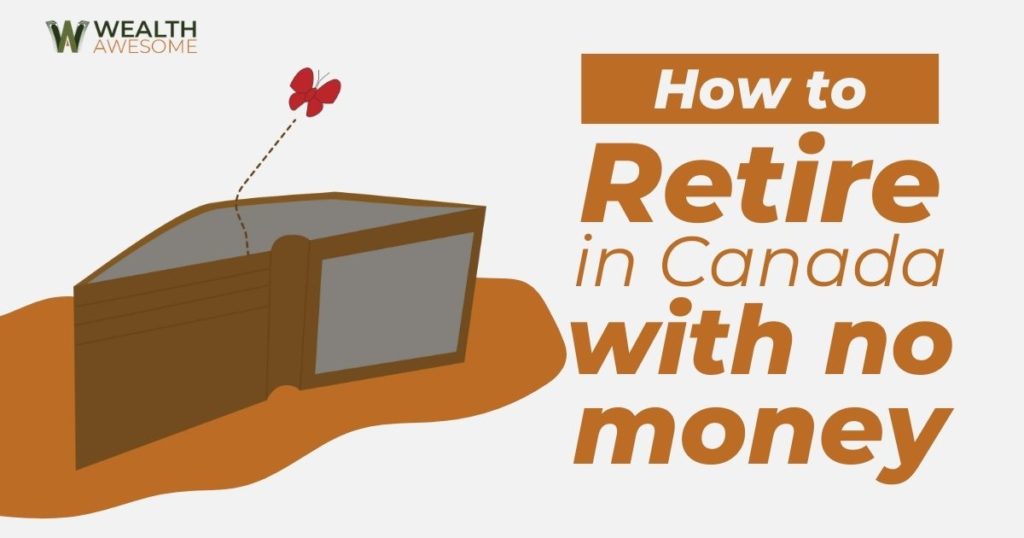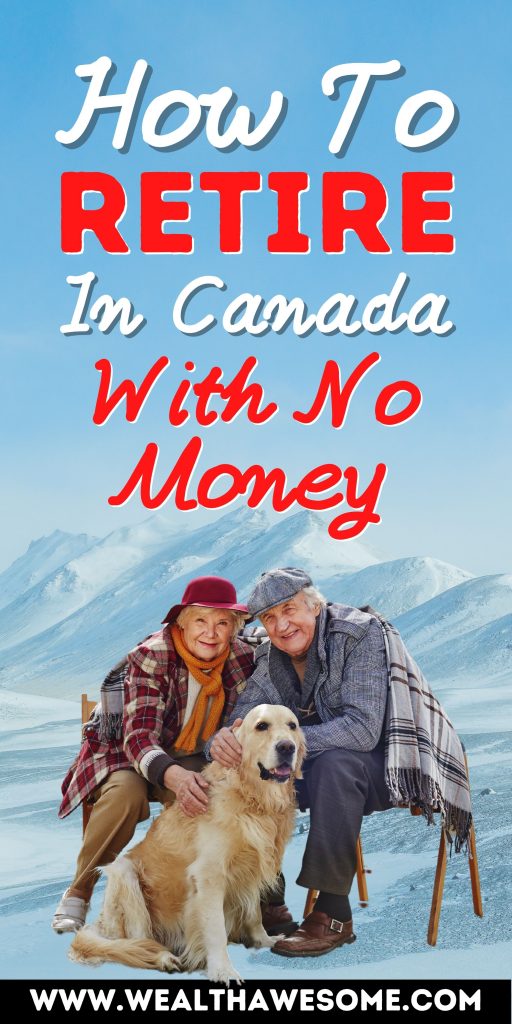If you’re like most people, you’ve been looking forward to retirement throughout most of your career. However, I also know that many Canadians don’t end up saving much money for their retirement.
In fact, 70% of Canadians think they won’t be able to save enough for retirement, which is an alarming figure. Are you one of those people who are wondering how to retire in Canada with no money?
Well, to be frank, it’s not going to be a walk in the park, but it isn’t impossible.
This post is my guide for older Canadian adults who are nearing retirement or right on the cusp of it without having substantial savings for their golden years.
How To Retire In Canada With No Money
First, let’s break down some of the living expenses you’re likely to face in retirement:
- Housing: This will be one of the largest expenses you’ll face in retirement.
- Healthcare: Medical costs can quickly spiral out of control. Canada’s healthcare system does cover many expenses, but not everything. Some prescription medications, specialized treatments, or long-term care may require out-of-pocket expenses.
- Groceries and Utilities: These are constant expenses. While you might save a bit by not commuting to work every day, you’ll still need to budget for these.
- Leisure and Travel: Yes, you should budget for fun too. Just because you’re retiring with less doesn’t mean you shouldn’t enjoy your golden years. Look for senior discounts and be savvy about spending to make your budget go further.
- Unexpected Costs: Things happen. Your car breaks down. Your roof needs repairs. These unexpected expenses can be particularly challenging when you’re on a fixed income.
When you retire with little to no money set aside, you will need to take steps to get yourself on a balanced and sustainable budget. Here are a few of the things that you can do to achieve that goal:
1) Consider Moving To A Cheaper Place
Nobody wants to downsize their living arrangements. However, it might become necessary to learn how to retire in Canada with no money.
You might be living in a large house that you bought, considering your requirements as a family. But with no more financially dependent children, a large house with empty rooms doesn’t make financial sense.
Selling your house and moving to a smaller apartment can free up substantial equity in your home. Considering the inflated housing prices today, it can provide you with a sizeable amount for your living expenses during retirement.
2) Reprioritize Your Budget
Go through each category in your budget and think hard about what you can reduce or entirely remove.
For instance, if you have a subscription to multiple streaming platforms, you might not need all of them. Consider cutting off your subscriptions and retaining only the ones you use most often.
It’s ideal to have a bare-bones budget that suits your retirement income but leaves some wiggle room for spending and entertainment.
3) Tax Credits And Benefits For Seniors With Low Income
Canada offers multiple tax credits and benefits for low-income seniors. I will list down just a few of them to help you understand the wealth of options you have that you can apply for:
- Provincial Land Tax Deferral Program for low-income seniors
- Ontario Drug Benefit Program
- Ontario Guaranteed Annual Income System payments for seniors
- Guaranteed Income Supplement
- Trillium Drug Program (for help with high prescription drug costs)
- Ontario Seniors’ Public Transit Tax Credit
4) Use Public Transport
You might not like the idea if you love driving, but vehicle maintenance is costly in Canada.
You can cancel your vehicle insurance once you sell your vehicle, providing you with a lot more wiggle room in your budget. You won’t need to pay money for maintenance either, and, depending on the condition of your vehicle, you stand to earn a reasonable amount from the sale.
5) Seek affordable housing options:
Canada offers various affordable housing programs for seniors, including subsidized housing and cooperative housing. Research your options and apply for the appropriate programs.
6) Consider part-time work or freelancing
Even in retirement, you may be able to generate some income through part-time work or freelancing. This can help supplement your budget and provide financial stability. Here are some ideas on work-from-home jobs without a degree in Canada.
7) Leverage community resources:
Many communities offer free or low-cost activities, services, and resources specifically for seniors. This can include recreation centers, libraries, meal programs, and transportation services.
8) Save on transportation costs:
Consider using public transportation, carpooling, or walking/biking to save on transportation costs. Some communities may offer discounted or free public transportation for seniors.
9) Embrace a frugal lifestyle:
Adopt a frugal mindset by cutting back on non-essential expenses, shopping at discount stores, buying second-hand items, and cooking at home.
10) Network and seek support
Connect with friends, family, and community members who may be in a similar situation or have valuable advice. They may be able to provide emotional support, resources, or even financial assistance.
Related Reading: How to save money in Canada.
Retirement Income Sources For Those With no Savings

You stop working when you retire, and that means you stop generating active income. However, that doesn’t mean you don’t receive any money. One of the perks of retiring in Canada is that you have access to several retirement income streams.
Your income after retirement typically comes from four primary sources:
- The Canada Pension Plan (CPP), or the Quebec Pension Plan (QPP),
- The Old Age Security (OAS),
- Guaranteed Income Supplement (GIS),
- Employer-sponsored pension plans, personal savings, and investments.
These four retirement income streams are also referred to as the three pillars of Canada’s retirement income system. While you may have no personal savings, that doesn’t mean you will see zero income in your golden years.
You should know about these retirement income streams to understand how much you might get from them and plan for your retirement.
1. Canada Pension Plan or Quebec Pension Plan
The CPP and QPP are pension plans that pay you monthly payments, provided you contributed to the plans during your working years.
The Canada Pension Plan Investment Board (CPPIB) manages CPP contributions. The CPPIB invests your contributions to ensure that there is enough capital in the plan to provide monthly payments to current and future Canadian retirees.
The monthly amount you can expect to receive through CPP depends on how long and how much you contributed to it. The amount also depends on when you decide to begin collecting your CPP or QPP.
You can choose to start collecting your CPP or QPP as early as 60 years old. You can delay it until you turn 70. The later you begin collecting your CPP or QPP, the more substantial your monthly payments will be.
Read this full overview on CPP for more information on how much you can receive and when you should start it.
2. Old Age Security
The OAS pension is a monthly benefit designed for Canadians who are 65 or older. This is a government-sponsored pension plan, and you can receive the monthly payments regardless of whether you’re still working or have never worked.
Being a government-sponsored program means you don’t have to contribute to the OAS pension to benefit from it. You can choose to begin collecting OAS payments at 65 years old or delay it until you turn 70. The OAS pension increases by a small percentage for each month you delay collecting it.
Qualifying for OAS requires being a legal resident or citizen in Canada for at least 10 years. The amount you receive through the OAS pension depends on how long you’ve lived in Canada since you turned 18. You can typically expect to receive the maximum OAS monthly payments if you have lived in Canada for over 40 years.
Read this to learn more about the OAS and how much you can possibly receive.
3. Guaranteed Income Supplement
The Guaranteed Income Supplement (GIS) offers a monthly non-taxable benefit for OAS recipients with low income. You will need to file your income tax return each year to qualify. It doesn’t matter if you don’t expect to pay extra taxes; filing your income tax each year is a critical requirement.
The Allowance is another benefit available to low-income Canadians. If you’re a Canadian retiree between 60 and 64 years old and have a low income, you might qualify for the Allowance, provided your spouse or common-law partner qualifies for the OAS and receives it.
Read this to find out more about GIS payments.
4. Employee Pension Plans

Employee pension plans come in all shapes and sizes. Some are self-directed, while others are employer-sponsored. There are also pension plans that combine self-directed and employer-sponsored pensions.
Regardless of what option is available to you, it’s a wise idea to capitalize on any opportunity where your employer is helping you save for your retirement.
Some plans involve employers exclusively contributing to a vested retirement plan. It means that if you stick to working with the same employer until your retirement, it pays out in full, provided you have completed the specified years of service with the employer.
Other pension plans allow you to set aside a certain amount from each paycheck to contribute to your retirement. Your employer may or may not contribute a percentage or dollar amount based on your contributions.
Some employers make no contributions to such a plan but allow you to create forced savings by offering to set aside money into a Registered Retirement Savings Plan (RRSP) before calculating your paycheck.
Self-Directed Pensions and Savings Plans
Since I am discussing how to retire in Canada with no money, we will suppose that you didn’t contribute to self-directed pensions and savings. However, it is worth briefly understanding the different options available.
Registered Retirement Savings Plan
An RRSP is a savings account designed to help Canadians save money for retirement.
Contributions you make to your RRSP enjoy a tax-deferred status and come in several types of investments. Your income from any of your RRSP investments will grow without incurring taxes, provided you remain invested in your assets. This allows your portfolio to grow substantially by the time you retire.
Registered Retirement Income Fund
A Registered Retirement Income Fund (RRIF) is a tax-deferred retirement plan that comes after the RRSP.
You can create an RRIF when you turn 55, or you can choose to keep your RRSP intact. After you turn 71, the entirety of your RRSP is automatically transferred into an RRIF without incurring any taxes.
Tax-Free Savings Account
The TFSA is just like any other savings account, with some differences that make it such a popular investment vehicle.
You can set aside a particular amount each year and contribute to your TFSA within the government-defined contribution limit. You can also remove your money from a TFSA without incurring any penalties or taxes, unlike with an RRSP.
The money in your account accumulates interest income that is higher than the interest you can earn in traditional savings accounts. The tax-free nature of TFSAs sets them apart, and unlike RRSPs, you can make tax-free withdrawals from TFSAs.
Like the RRSP, you can use your TFSA contribution room to hold other investments that generate higher returns than interest income. This way, you can accelerate your wealth growth to build a sizeable retirement nest egg.
Related Reading: Add LINK here
How Much Money Will You Need In Retirement?
According to a CIBC survey from 2018, Canadians estimated they would need $756,000 on average to retire comfortably. It’s only an estimate, though, and isn’t based on fundamentals.
Surveys aside, it’s vital to plan for retirement by determining how much you will need to be comfortable.
How much you need to retire varies greatly on how you live now. Additionally, where you plan to retire and how you plan to spend your golden years make a world of difference. You can find online retirement calculators that can provide you with some perspective on how your personal income, savings plan, and life goals impact your retirement savings requirements.
Typically, the rule of thumb here is that you will need at least 70% of your pre-retirement income to live comfortably as a retiree. If you’re planning to have a mortgage during your retirement, you may need as much of your pre-retirement income levels as possible.
However, if you are one of the lucky few who don’t have to contend with a mortgage, you may be fine with far less.
Calculating Your Retirement Income Requirement

There are several schools of thought when it comes to determining how much you might need to retire comfortably in Canada.
If you’re looking for a specific number, you might be disappointed. There’s no crystal-clear figure that applies to everybody, but one or more of these rules of thumb might be suitable for you.
1. 4% Withdrawal Rate
The 4% withdrawal rule implies that you should create a retirement income portfolio that offers a certain amount of retirement income from which you can withdraw 4% each year. Many consider this withdrawal rate to be sustainable.
Suppose you have determined that you can live comfortably with $38,000 per year in retirement. In that case, a 4% withdrawal rate means that you should have at least $950,000 in your nest egg before you retire.
2. 70% Of Pre-Retirement Income
This rule estimates that you will need at least 70% of the income you were making before your retirement, provided you don’t have a mortgage to contend with in your golden years.
Suppose you’re still paying off a significant mortgage. The rule implies that you need 100% of your pre-retirement income during your retirement.
The basic idea is that you will deal with fewer expenses in retirement because you no longer have financially dependent kids, no longer need to save for retirement, and no longer need to pay a mortgage. You can calculate the sum you will need for Rule 1 after calculating this amount.
3. Pre-Retirement Income Times 10-14
This rule suggests that you calculate what you’ll need for your retirement by multiplying your income right before retirement by a number between 10 and 14.
Suppose that your income right before you retired was $75,000 per year. In that case, following this rule means that you should save at least:
- Multiple of 10: $75,000 x 10 = $750,000
- Multiple of 11: $75,000 x 11 = $825,000
- Multiple of 12: $75,000 x 12 = $900,000
- Multiple of 13: $75,000 x 13 = $975,000
- Multiple of 14: $75,000 x 14 = 1,050,000
The rule assumes that you are using the income generated during your highest income-earning years to base your calculations.
These rules are not written in stone and can differ for every individual based on their requirements, lifestyle choices, and other factors. However, they can give you a fair idea of how much you might need for a comfortable retirement.
FAQs
- How much money is needed to retire in Canada without a pension?
- On average, one might need between $500,000 to $750,000 saved, but this depends on individual lifestyles, debts, and desired post-retirement activities.
- What is the average retirement income in Canada?
- The average retirement income in Canada is approximately $8,000 to $15,000 per year from government sources alone. However, total income varies depending on personal savings, investments, and other sources.
- How can someone retire at 60 with no money in Canada?
- Retiring at 60 with no money involves relying on government programs like CPP and OAS, considering part-time work, reducing living expenses, utilizing community resources, and possibly leaning on family or charity support.
- What happens if someone has no money when they retire in Canada?
- Individuals with no money in retirement may qualify for government assistance such as the Guaranteed Income Supplement (GIS). They might also need to adjust their lifestyle, seek low-cost housing, or consider part-time employment.
- Can someone retire with no savings in Canada?
- Yes, but it will be challenging. They would primarily rely on government benefits like CPP, OAS, and GIS and might need to make significant lifestyle adjustments.
Conclusion

I understand that retiring as a millionaire is not possible for everyone, but that doesn’t mean that you can’t enjoy your retirement.
It will be tough to retire with no savings, but depending on your standard of living and other forms of retirement income, it may be possible for you to do.
Learning how to retire in Canada with no money by understanding your options and making wiser financial decisions can help you enjoy your twilight years without worrying about your financial situation.
I highly recommend saving for retirement so you can better enjoy your golden years.
You should read my guide on how to make money online in Canada if you want to learn how to generate some extra cash. You can also check out my guide on the best coupon apps in Canada to learn about exciting ways to save money while shopping and improve your budget for a more comfortable retired life.






What about in the United States?
How does this help to an already retired individual with no savings at hand being like majority Canadians who live pay check to pay check with no savings possible at all, but contrarily indebted to credit cards till retirement.?